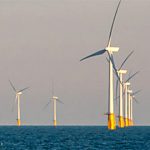The U.S. offshore sector must create regional East Coast supply chains and public-private initiatives that accelerate training and port investments to ensure long-term competitiveness, leading developers told the U.S. Offshore Wind 2019 Conference.
New Jersey’s recent decision to select Ørsted’s giant 1.1 GW Ocean Wind project for its first large-scale facility highlights the rapid growth taking place in the U.S. offshore wind sector.
The 800 MW Vineyard Wind 1 and 2 project in Massachusetts will dominate installation activity in 2020-22, but deployment will rapidly spread to other states. By 2023, annual U.S. offshore installations are forecast to hike to 1.8 GW and remain between 1.2 GW and 2.2 GW between 2024 and 2030, according to BloombergNEF.
European offshore wind specialists have flocked to the emerging U.S. offshore wind market, partnering with U.S. firms to gain a competitive edge.
European project learnings have sliced prices and boosted demand for U.S. projects. Contracted U.S. offshore wind capacity is forecast to rise to about 4 GW by the end of 2019, the University of Delaware said in a recent report. A further 5.5 GW of new capacity is expected to be procured in 2020-2022, followed by 6.4 GW in 2022-2025, it said.
Growing demand from state authorities and utilities is supporting the development of a U.S. offshore wind supply chain but challenges remain, leading developers told the conference in Boston on June 10.
To become competitive, the U.S. offshore wind sector must take a wider regional approach to supply chain buildout and work with U.S. institutions to create hiring and port infrastructure solutions, developers said.

The Vineyard Wind project, co-owned by Avangrid Renewables and Copenhagen Infrastructure Partners represents the U.S.’ first large-scale offshore wind project and is made up of two 400 MW units.
In July 2018, the project partners secured 20-year power purchase agreements (PPAs) with Massachusetts electric distribution companies (EDCs) at starting prices of $74/MWh for unit 1 and $65/MWh for unit 2. Taking into account tax credits and additional revenue streams, the levelized revenue of energy (LROE) for the entire project is estimated at $98/MWh, competitive with some European projects despite the lack of local infrastructure, the U.S. National Renewable Energy Laboratory (NREL) said in a report.
The Vineyard Wind project will install 9.5 MW MHI Vestas turbines, the largest capacity turbines currently available on the market. Turbine capacities are continuing to rise as developers seek to boost revenue and reduce the levelized cost of energy (LCOE).
MHI Vestas recently opened its first U.S. office in Boston, and the company is planning to hire abuot 40 technical staff in the U.S. ahead of turbine installation in 2021, Philippe Kavafyan, CEO, MHI Vestas, told the conference.
“We are gearing up,” Kavafyan said. “The first challenge is to ramp up and bring up to speed with the right training, the technicians we will need to drive the construction phase, and the services phase of this project.”
Training will be conducted at European projects this year, he said.
The strong U.S. labor market is creating hiring challenges, and offshore operators will need to work with colleges, unions, and state and federal governments to implement efficient training programs, said John Hartnett, CEO of Mayflower Wind, a joint venture by Shell and EDP Renewables.
“Finding staff for our companies in the front-end development and execution phases is extremely challenging — there is competition within the industry as well as competition across all industries,” Hartnett said.
More info www.newenergyupdate.com





































